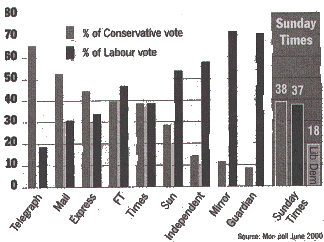
|

| British
newspapers can be split up into three categories: the Quality, the Popular
and the Middle Market Press. This division applies to daily as well as
Sunday papers. |
| XXX |
Quality (broadsheet) |
Popular (tabloid) |
Middle Market
(tabloid) |
| Daily
Papers |
Times
/ Guardian / Daily Telegraph / Independent / Financial Times |
Sun
/ The Mirror / Daily Star |
Daily
Mail / The Express |
| Sunday
Papers |
The
Sunday Times / The Observer / Sunday Telegraph / Independent on Sunday |
Sunday
Mirror / News of the World / The People |
Mail
on Sunday / The Express on Sunday |
There
are 10 national daily papers selling a total of over 13 million copies a
day. 55 % of the adult population of GB read at least one national daily.
There are 9 national
Sunday papers selling over 15 million copies each week and 60 % of the
adult population of GB read at least one national Sunday paper.
The readership
of newspapers are commonly divided into 6 classes of social status: |
| Category and
social status |
Occupation /Job |
| A (upper
middle class) |
higher managerial,
administrative and professional positions |
| B (middle
class) |
intermediate managerial,
administr. and prof. positions |
| C1 (lower
middle class) |
clerical, junior
managerial, administrative jobs |
| C2 (skilled
working class) |
skilled manual workers |
| D (working
class) |
semi- and unskilled
workers |
| E (lower
class) |
state pensioners,
widows |
| It
is therefore common to refer to 'ABC1' s, as they are the people with the
greatest disposable income. Typical target audiences are women aged 25-44,
petrol buyers, AB men, or adults who take holidays twice or three times
a year. Market research institutes can exactly find out by the use of questionnaires
what readership the different newspapers attract and what these can do
to attract more readers. |
| Links to UK newspapers
can be found in the LINKS SECTION |
Political Affiliation of Newspaper Readership:

|

